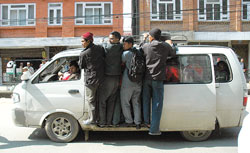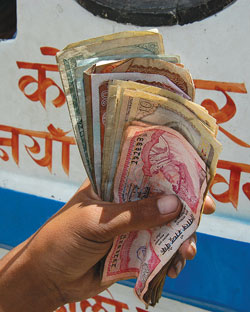 The woman who took the seat next to me had something suspicious under her billowy red shawl. She had one hand tucked underneath as the Swayambhu Yatayat lurched and swayed along the Ring Road. Suddenly there was a clucking sound from under the shawl and I found myself face to face with a huge chicken.
The woman who took the seat next to me had something suspicious under her billowy red shawl. She had one hand tucked underneath as the Swayambhu Yatayat lurched and swayed along the Ring Road. Suddenly there was a clucking sound from under the shawl and I found myself face to face with a huge chicken.
Its deep red comb pulsating, sharp beak inches from my nose and beady little eyes staring unblinkingly into mine, I let off a shriek. That is the beauty of Kathmandu's public transportation network: it's a free for all and you never know what drama you're going to encounter when you get on. Sometimes it is an instant chukka jam at Kalanki, at others a major fist fight between the conductor and a bunch of forty-year-olds who want a student discount, and just the other day there was commotion when the bus driver drove away even before an alighting passenger could take down a goat he had stowed on the roof.
|
|
Then there are the microbuses that also circle the Ring Road. With white plates, these road demons will get you wherever in half the time but often charge double of what the blue buses do. Public transport in the inner city is chaotic. Microbus routes go from everywhere to everywhere and back but even after four years of commuting I haven't figured them out. There are little-known tempo routes that use the gullies, which is a great way to go during chukka jams on the main roads. Micros are the fastest, but it's a bit unnerving because the drivers think they're in the Formula One.
 "We have to compete with other microbuses," says Raja Ram Thapa, a micro driver on the Ratna Park-Chabahil route," we cannot afford to waste time on the road." It's a race against time, and it's a race to haul in as many passengers as possible to maximise daily earnings for the driver and conductor. Woe to any passenger unlucky enough to get stuck in one of these contests.
"We have to compete with other microbuses," says Raja Ram Thapa, a micro driver on the Ratna Park-Chabahil route," we cannot afford to waste time on the road." It's a race against time, and it's a race to haul in as many passengers as possible to maximise daily earnings for the driver and conductor. Woe to any passenger unlucky enough to get stuck in one of these contests.
Some micros and buses have numbers. Ignore them. The numbers are irrelevant and routes change from day to day. For example, route 5 is supposed to take you from RNAC (yes, still called that) to Ratna Park, Lazimpat, Jamal, Bansbari upwards, but sometimes it goes to Basundhara without warning. It pays to be alert about any change of plans en route. "We've had the same number for years, even though we've changed routes at least five times," says Bishnu, a conductor on the Ratna Park-Kalanki route with pride.
For the best value ride in town use the trolley bus, almost no one rides on it and it causes no pollution. The only problem is that this near-defunct state-run electric transport runs only between Baneswor and Tripureswor and once every half-hour.
 An upside to using public transportation is that you meet all kinds of interesting people. I personally have met former teachers, made friends with an Australian woman, sat face-to-face with a rooster, talked to a sadhu on the benefits of marijuana, got a college girl's number, and even have had my thigh molested.
An upside to using public transportation is that you meet all kinds of interesting people. I personally have met former teachers, made friends with an Australian woman, sat face-to-face with a rooster, talked to a sadhu on the benefits of marijuana, got a college girl's number, and even have had my thigh molested.
Yup, it's not just girls. If someone tries to get touchy feely make a hue and cry. People almost always come to the rescue of a damsel in distress.
A man once tried to feel me up on a bus, but I yelled and other people immediately started to tell the person off," says Shilpa Shrestha, a 12th grade student who commutes to school and back every day.
If you want to see the real Kathmandu, take the bus. Travel with the masses. What you lose in time, you make up in money, and experience.
Micro tips
|
|
If you do have to take the micro because you are in a rush, here are a
few tips:
. No low-slung shirts, no low-rise jeans, no saris.
. Carry a big bag, more difficult to snatch and can be used as a weapon if someone gets too close
. Choose a seat near the window (polluted outside air is better than indoor pollution)
. Sit towards the front to make it easier to get in and out
. Never sit on the small seat near the door unless you want your nose stuck inside the conductor's armpit
. Best seat is up ahead in business class next to the driver
. Have your fare ready (in small change) so you don't reveal the location of your wallet
. If the sleazebag next to you starts to get physical, scream. Jab the guy with your elbow or tell him you're YCL.




